Repatriation Commission Outpatient Clinic
The Repatriation Commission Outpatient Clinic at 310 St Kilda Road, Melbourne, Australia, is an Art Deco building of architectural and historical significance as the only remaining Repatriation Commission Outpatient Clinic or Commonwealth building built for the health and wellbeing of the original ANZACs (i.e, World War I veterans).
| Repatriation Commission Outpatient Clinic | |
|---|---|
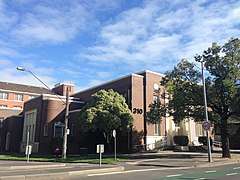 Repatriation Commission Outpatient Clinic | |
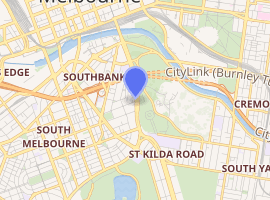
| |
| General information | |
| Architectural style | Art Deco |
| Town or city | 310 St Kilda Road, Melbourne |
| Country | Australia |
| Coordinates | 37.828492°S 144.970900°E |
| Construction started | 1936 |
| Completed | 15 November 1937,[1] 82 years ago |
| Cost | £24,000 |
| Client | Repatriation Commission |
| Owner | Department of Defence, Australia |
| Design and construction | |
| Architect | George Hallendal |
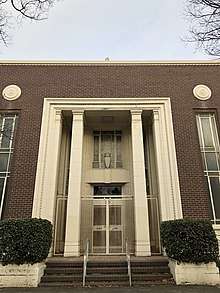
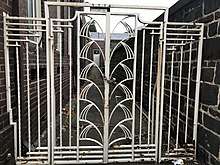
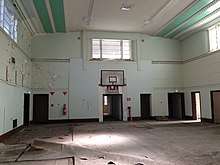
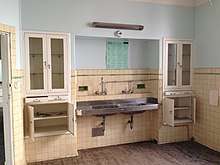
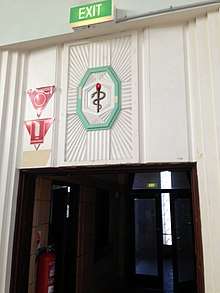
Significantly the building was constructed for the ANZACs of World War I nearly 20 years after the end of the war. The clinic subsequently supported the wellbeing of veterans of World War II, Korean War and Vietnam War. The Australian veteran community consider it a sacred place due to the connection to the suffering of veterans returned from those wars.
Post-World War I
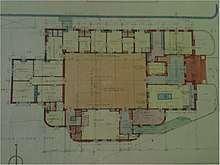
In 1936 the Repatriation Commission took control of a parcel of land on the corner of St Kilda Rd and Coventry St from the Department of Defence to construct a facility to address the needs of the large population of World War I veterans.
'The out-patient clinic, which is at present within the Branch Office on St. Kilda-road, Melbourne, is so congested that no longer can the conditions be allowed to remain, and plans have been prepared for the erection of an out-patient clinic on a site made available by the Defence Department. All preliminaries have been hastened and an early commencement of the work of construction is anticipated.'[2]
'With increasing numbers requiring out-patient treatment, the accommodation at the Branch Office in St. Kilda-road was inadequate. Men suffering from all types of disabilities, many of them accompanied by their wives and children, had to sit in a basement waiting room. Another inconvenience through lack of space was the necessity for accommodating two medical examiners in each of the small cubicles built as examination rooms. These disabilities, together with other factors, made it imperative that better conditions should be provided. It was decided to erect a new out-patient clinic, the building embodying the latest facilities, including air conditioning, single rooms for medical examining officers, and a large general waiting room.'[3]
On this site the Repatriation Commission Outpatient Clinic was built adjacent to Victoria Barracks, Melbourne, it was opened on 15 November 1937,[4] to provide a greater level of care to veterans. The building was designed by George Hallendal, under the supervision of Commonwealth Works Department Director, H. L. McKennall. Within months of opening as many as 400 prescriptions were being administered daily.[5]
The design of the Repatriation Clinic created some controversy with Sir Arthur Streeton criticising[6] the use of brown brick in contrast to the established bluestone brick of Victoria Barracks.
Original functional spaces
- Reception
- Large central waiting hall
- Pharmaceutical dispensary and store room
- Ducted heating
- Medical examination rooms
- Clarks offices
- Theatre for minor surgery procedures
- Dressing station
- Sisters office
- Nursing examination office
- Massage
- Administrative offices
- Archives file room
The Repatriation Commission 1938 Annual Report to the Australian Parliament the Commission stated 'The Repatriation Clinic opened in St. Kilda Road, Melbourne, in November, 1937, now provides satisfactory conditions for those patients whose ailments need out-patient supervision and treatment. All modern facilities except those which can only be provided in large centres, e.g. deep X-ray and Radium Therapy, are available at this institution. The Commission is gradually adding to the therapeutic armament at its institutions, so that the medical staffs will not be handicapped in their efforts to aid their patients... The spacious warmed waiting hall has proved a great boon to the patients, and the improved conditions for the medical and other staffs are greatly appreciated.'[7]
Post-World War II
Up to 250 veterans visited the clinic each day. An extension was added to the building in the late 1940s for a war neurosis clinic, designed by D. B. Windebank.[8]
Based on the success of the addition of the neurosis clinic in 1950 the Minister for Repatriation, Senator W. J. Cooper, and the Repatriation Department, planned to establish outpatient clinics for psychiatric treatment in all capital cities.
Since the clinic was opened the Australian Red Cross maintained a canteen where tea, coffee and biscuits were provided. As many as 25 volunteers ran the canteen on a non-profit basis to support and comfort the veterans waiting for their appointments. Between 200 and 250 where served by the Red Cross on a daily basis between 10am and 4pm.
The Repatriation Clinic ceased operations in 1980 and was handed back to the Department of Defence. From this point it was used as the Maintenance Engineering Agency (MEA), now the Land Engineering Agency (LEA), until December 1995. The Parliamentary Standing Committee on Public Works considered a proposal in 1993 to repurpose the building into its original purpose as the Defence Health Care Centre (DHCC) at a cost of $1.3million, which was not approved.[9] The former Repatriation Clinic has been reportedly vacant since 1999[8] while the MEA newsletter (Maintenance News) No's. 66 (Sep 1995) and 67 (Dec 1995) indicates the last organisation to occupy the Repatriation Clinic moved out in 1995.
On 15 November 2017, the 80th anniversary of the opening of the Repatriation Clinic, Senator Derryn Hinch moved motion no.563 in the Senate to acknowledge the event and the significance of the clinic to the wellbeing of the veteran community while Victorian Member of Parliament, Tim McCurdy, acknowledged the milestone in the Parliament of Victoria.[10]
The clinic's future
After the clinic had been sitting vacant for nearly two decades, the Shadow Minister for Veterans' Affairs, David Feeney, delivered an adjournment speech[11] to the Australian House of Representatives on 26 March 2015 expressing his support for the proposal raised by the ex-service organisation and veterans charity, the Australian National Veterans Arts Museum (ANVAM) to turn the "unused building back to its original glory and once again help aid in repatriating our returned soldiers back into the community through the use of art rehabilitation". Within two months, on 6 May 2015, the Department of Defence added the Repatriation Clinic to its Disposal Program.
The Australian Labor Party (ALP) released a policy[12] on 17 June 2016 to turn the clinic into an Australian National Veterans Arts Centre (ANVAC) following lobbying by ANVAM.
In the same year the Department of Defence indicated the former Repatriation Clinic would be sold that attracted some political[13] and media attention.[14] Later the Department of Defence indicated negotiations were underway to transfer the property to the State Government of Victoria. A nomination[15] was submitted to Heritage Victoria for the listing of the Repatriation Clinic on the Victorian Heritage Register. A report (Ref: 200349) was prepared for the Victorian Heritage Council in May 2017 noting that "The Former Repatriation Outpatients Clinic has a special association with returned service personnel from conflicts since World War I. For present day returned personnel, the place provides a strong emotional connection to past veterans and their experiences of war trauma and disability". The report was not considered by the Council pending the outcome of the sale process.
A Change.org petition undertaken by ANVAM during 2017 to "Save the WW1 Heritage Building at 310 St Kilda Rd to Help Veterans" attracted over 13,600 signatures supporting ANVAM's proposal to return it to the veteran community as a cultural centre for veterans wellbeing.
Amanda Rishworth, Shadow Minister for Veterans' Affairs, restated the Australian Labor Party's commitment to dedicating the property for veterans arts in April 2017.[16]
As part of its community engagement program, ANVAM worked with RMIT interior design students in 2017 to envision potential designs for the clinic as a cultural institution with some projects presented online.[17]
The future of the property was first raised in Senate Estimates by Senator Derryn Hinch on 1 March 2017[18] and further discussed or raised through questions on notice (QoN) on the following dates:
- 29 May 2017 Senator Alex Gallacher[19]
- 25 Nov 2017 Senator Alex Gallacher[20]
- 28 Feb 2018 Senator Kimberley Kitching[21]
- 30 May 2018 Senator Alex Gallacher and Senator Kimberley Kitching[22]
- 24 Nov 2018 Senator Alex Gallacher[23]
- 23 Nov 2019 Senator David Van QoN[24]
- 23 Nov 2019 Senator Kimberley Kitching QON[25]
In its response to Questions on Notice from the 30 May 2018 Senate Estimates, Defence indicated the sale is progressing in accordance with the Commonwealth Property Disposal Policy (CPDP). Defence also indicated the site was surplus to Defence requirements.
On 20 March 2019 the Assistant Minister for Defence, Senator David Fawcett, instructed the Department of Defence to progress the sale of property. When asked by Jon Faine on ABC Radio Melbourne on 25 March 2019, Darren Chester, Minister for Veterans' Affairs, indicated he was supportive of the initiative to establish a cultural institution for veterans wellbeing but unaware of the decision to sell the property despite his ministerial appointment. Senator Fawcett reversed the decision on 28 March 2019 prior to caretaker period for the 2019 Federal Election commencing on 10 April 2019.
As an expression of tri-party support the three primary candidates for the Division of Macnamara in the 2019 Federal election, Josh Burns (ALP), Kate Ashmor (Liberal) and Steph Hodgins-May (Greens), publicly endorsed the initiative to create a cultural institution for veterans wellbeing during a community forum on 16 April 2019.[26]
Amanda Rishworth released the Australian Labor Party's 2019 election veterans policy re-stating that "it is a site of significance for many in the veterans' and ex-serving community" and committing to its future for the benefit of the veteran community on 10 May 2019.
Veterans' war service
Veterans who attended the Repatriation Clinic between 1937 and 1975 for medical and allied health support saw service in the following wars:
Notable patients
Notable veterans who attended the Repatriation Clinic:
- James Rogers (Australian soldier) VC was a Boer War and World War I veteran and Victoria Cross recipient from action during the Boer War.
- LTCOL James Newland VC served in the Boer War, World War I and World War II and Victoria Cross recipient from action in France during WWI.
- 20178 BDR Napier Waller CMG OBE was wounded while serving in France during World War I. He used art to rehabilitate later awarded Imperial Honours for services to art.
- VX16999 L/SGT Joseph (Joe) Newton who served as an RASigs linesman in Crete and Papua New Guinea during World War II. He is the father of TV personality Bert Newton.
Staff
- Miss May Duggan, Sister-in-Charge, 1937
- Dr. J. V. Griffith
- Dr. R. S. Kennedy
Red Cross staff
- Mrs R. S. Hammerberg
- Mrs W. E. Fyfe (original volunteer)
- Miss I. Haig (original volunteer)
References
- "NEW DIGGERS' CLINIC". The Weekly Times (2, 390). Victoria, Australia. 18 September 1937. p. 7. Retrieved 1 October 2018 – via Trove., Costing £16.010, the new clinic for out-patients of the Repatriation Commission in St. Kilda Road, Melbourne, adjacent to Victoria Barracks, will be opened in a month
- "Annual Report to Parliament 1 July 1936". ACT, Australia. 1 July 1936. p. online. Retrieved 2 March 2020 – via Trove., The Branch Office is so congested that no longer can the conditions be allowed to remain.
- "Annual Report to Parliament 1 July 1937". ACT, Australia. 1 July 1937. p. online. Retrieved 2 March 2020 – via Trove., It was decided to erect a new out-patient clinic, the building embodying the latest facilities, including air conditioning, single rooms for medical examining officers, and a large general waiting room.
- "SOLDIER PATIENTS £24,000 CLINIC". The Herald. Victoria, Australia. 11 November 1937. p. 12. Retrieved 1 October 2018 – via Trove., THE new building will re-place the present obsolete clinic in the basement of the Department's central ad-ministrative building. These quarters, designed only as a makeshift, are over-crowded, ill-lit and old-fashioned, and have long ceased to meet the require-ments of the medical staff and the daily average of 200 patients who are treated at the clinic.
- "SOLDIERS' OUTPATIENTS CLINIC". The Evening News. Queensland, Australia. 22 January 1938. p. 2. Retrieved 1 October 2018 – via Trove., The Minister for Repatriation (Senator Foll) said today that the out-patient clinic for ex-soldier, provided in Melbourne by the Repatriation Commission, was giving splendid service.
- "Brick Clinic in St. Kilda Road Condemned". The Argus. Victoria, Australia. 5 March 1937. p. 12. Retrieved 4 October 2018 – via Trove., "A building in this part of St Kilda road in anything but bluestone will ruin this magnificent boulevard" said Sir Arthur Streeton yesterday.
- "Annual Report to Parliament 1 July 1938". ACT, Australia. 1 July 1938. p. online. Retrieved 1 March 2020 – via Trove., The spacious warmed waiting hall has proved a great boon to the patients, and the improved conditions for the medical and other staffs are greatly appreciated.
- "Former Repatriation Outpatient Building - Victoria Barracks". Victoria Heritage Database. Heritage Council of Victoria. Retrieved 6 October 2018.
- "Parliamentary Standing Committee 1993". ACT, Australia. 2019. p. online. Retrieved 6 May 2019 – via APH., 310 St Kilda Road now resembles a 'rabbit warren' which could be converted to its original function.
- "Remembrance Day". Vic, Australia. 15 November 2017. p. online. Retrieved 29 October 2018 – via Handsard., Today is the 80th anniversary of the opening of the former Repatriation Commission Outpatient Clinic at St Kilda Road.
- "David Feeney Adjournment Speech". ACT, Australia. 26 March 2015. p. online. Retrieved 17 May 2019 – via APH., A proposal ... which I find myself passionate about, is to turn this unused building back to its original glory and once again help aid in repatriating our returned soldiers back into the community through the use of art rehabilitation developed by the ANVAM initiative, a national tribute to military veterans and families.
- "The Australian National Veterans Arts Centre in Melbourne". Vic, Australia. 17 June 2016. p. online. Retrieved 4 October 2018 – via APH., The building will be remediated and restored by the Department of Defence, before being returned to its original purpose as a centre caring for veterans.
- "Government miss opportunity to help our veterans". Vic, Australia. 14 February 2017. p. online. Retrieved 7 October 2018 – via APH., An opportunity has gone missing for the Turnbull Government to help veterans as Defence confirm the sale of 310 St. Kilda road at Victoria Barracks.
- "Arts, not apartments, says veterans' group as defence building goes to sale". The Sydney Morning Herald. NSW, Australia. 20 February 2017. p. online. Retrieved 27 April 2019 – via SMH., ...its proposed sale has been greeted with fury by a small band of veterans who, for three years, have quietly lobbied the department to turn it into an art gallery for returned service men and women.
- "Nomination for inclusion on Victorian Heritage Register" (PDF). National Trust. Vic, Australia. 28 April 2016. p. online. Retrieved 4 October 2018 – via Trustadvocate., The Former Repatriation Commission Outpatient Clinic also reflects the social impacts of war and the notable requirement for a wide range of services to support injured soldiers with recovery and reintegration into civilian life.
- "ALP Policy Commitment 6 April 2017" (PDF). ACT, Australia. 6 April 2017. p. online. Retrieved 25 March 2019 – via APH., Labor has long advocated for this project.
- "#130SKR Australian National Veterans Arts Museum". VIC, Australia. 2017. p. online. Retrieved 9 July 2019., The first phase of this project involved analyzing and learning about museum spaces in relation to preservation, restoration, and reuse.
- "Senate Estimates 1 March 2017". ACT, Australia. 1 March 2017. p. online. Retrieved 27 February 2019 – via APH., I am aware of ANVAMs interest and engagement, yes.
- "Senate Estimates 29 May 2017". ACT, Australia. 29 May 2017. p. online. Retrieved 27 February 2019 – via APH., So 310 St Kilda Road has not been used by the Department of Defence for some considerable time.
- "Senate Estimates 25 November 2017". ACT, Australia. 25 November 2017. p. online. Retrieved 27 February 2019 – via APH., The ball is very much in the court of the Victorian government. We have been working with them for some months now.
- "Senate Estimates 28 February 2018". ACT, Australia. 28 February 2018. p. online. Retrieved 27 February 2019 – via APH., We are awaiting a response from the Victorian government in relation to their position.
- "Senate Estimates 30 May 2018". ACT, Australia. 30 May 2018. p. online. Retrieved 27 February 2019 – via APH., The situation at 310 St Kilda Road is unchanged since we last met. The situation is that the Victorian government in February last year expressed renewed interest in acquiring 310 St Kilda Road. We are assisting the Victorian government with their due diligence. They have not yet got to the point where they have made an offer to the department. So we are still awaiting that offer.
- "Senate Estimates 24 Nov 2018". ACT, Australia. 24 November 2018. p. online. Retrieved 6 March 2020 – via APH., Q.Is Defence aware of how much it will cost to remediate the site? If yes, how much?. A.Defence has considered the condition of the building in obtaining a sale valuation for the site. Defence does not publicly disclose its valuations, or contributing cost assumptions, ahead of achieving a divestment outcome.
- "Senate Estimates 23 Oct 2019". ACT, Australia. 23 October 2019. p. online. Retrieved 6 March 2020 – via APH., Q.What is Defence doing to rectify the (disrepair) issues of the site?. A.The site has not been occupied in over 20 years and would require significant refurbishment works to address building safety hazards and building code compliance to enable occupancy.
- "Senate Estimates 23 Oct 2019". ACT, Australia. 23 October 2019. p. online. Retrieved 6 March 2020 – via APH., Q.Can the department provide a status update in relation to the Defence property at 310 St Kilda Road, Melbourne?. A.Defence is currently working with the Council to explore this (off-market sale) opportunity, including interest by the (Melbourne City) Council in exploring the feasibility of an outcome to support a range of veteran’s wellbeing services.
- "Candidates talk Macnamara". VIC, Australia. May 2019. p. online. Retrieved 17 May 2019 – via Southbank Local News., "It’s a worthy project", Josh Burns said. "I see the vision and it touches on some of the desperate health challenges that veterans are facing and it does it in a way that is admirable and is worthy of support."